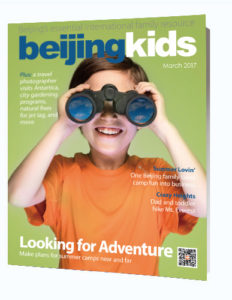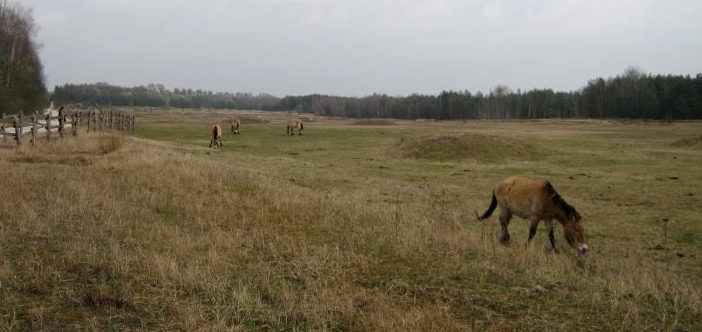“Is that them there?”
“What, those yellow blobs?”
“What yellow blobs?”
“Let me see, I want to see!”
Joseph grabs the binoculars, nearly strangling his brother, who has the strap around his neck.
“Right, that’s it,” I say. “Give me the binoculars, if you can’t be responsible with them.”
I ignore the whines and complaints of unfairness, and train the binoculars on the distant hillside.
“Well, those are definitely yellow blobs.”
We are looking for Przewalski’s horses, the only truly wild horse left in the world. It’s a hot day, in the Hustai National Park in Mongolia. We have traveled for several hours, along rough and often non-existent roads to get there, and since then have driven bumpily around the park in search of our quarry. The kids are getting a little wild themselves.
Our guide insists that the blobs are indeed the horses.
“But they’re not moving,” my wife says. “Are you sure they’re not rocks?”
“Can’t you see them?” our guide says. “They have darker manes and legs.”
Even through the binoculars, I can’t see any manes or legs. All I can see are blobs. Przewalski’s blobs.
 The eponymous Przewalski was a Russian explorer, who in the 19th century traveled deep into Central Asia and discovered, among other things, a new species (some say sub-species – let’s not quibble over detail) of horse. The news prompted a stampede of western naturalists, all determined to bring back foals for examination and exhibition. These brutally clumsy expeditions, combined with war and cold winters, drove the species to extinction in the wild within ninety years of their discovery.
The eponymous Przewalski was a Russian explorer, who in the 19th century traveled deep into Central Asia and discovered, among other things, a new species (some say sub-species – let’s not quibble over detail) of horse. The news prompted a stampede of western naturalists, all determined to bring back foals for examination and exhibition. These brutally clumsy expeditions, combined with war and cold winters, drove the species to extinction in the wild within ninety years of their discovery.
At one stage, there were only a dozen of these animals left in the world. A global breeding program brought a recovery of their numbers to the extent that they could be reintroduced to Mongolia. There are now over 200 in the Park, although their future remains precarious. And their presence elusive.
It’s understandable that they’re reluctant to get up close and personal with a species which nearly wiped them out. For a moment the cynic in me wonders whether those are really yellow rocks on the hillside, and guides bring gullible tourists here and tell them those are the famous wild horses.
This thought prompts further musing, on this whole business of sightseeing. I can now say I’ve seen Przewalski’s horse in the wild – box ticked. Yet beside the fact I can say I’ve done it, is it really a superior experience to watching a documentary about them? (Ironically, the projector in the visitor center was broken on the day we went, so we didn’t even get to see the film.) The same applies to marine animals in aquariums: you can’t smell, touch or even hear them. Would it be much different if the tanks were replaced with screens?
As video games become more sophisticated and immersive, and particularly as VR technology develops, the distinction between what’s a real experience and what’s not becomes increasingly blurred. As a gamer, I sometimes feel entitled to say, like Blade Runner’s Roy Batty, “I’ve seen things you people wouldn’t believe. Attack ships on fire off the shoulder of Orion. I watched C-beams glitter in the dark near the Tannhäuser Gate…” In contrast, the Mona Lisa in real life is a drab little smudge, Stonehenge disappointingly small, surrounded by busy roads and only visible from behind barriers.
We decide to agree that we’ve seen the horses, should anybody ask, and turn back for the van. The landscape of Hustai is stunning, sweeping chalk hills, rich with wildlife and fragrant with the scent of caryopteris. We see wild marmots scurrying across the grass (not mammoths, as my wife originally misheard our guide saying). Our guide is flirting with the pretty young park-keeper, showing off, singing Frank Sinatra for her in a heavy Mongolian accent. The children find an anthill; to our horror, he pulls the legs off a grasshopper and throws it in so we can watch the ants devour it in seconds. After the crowds and pollution of Beijing, it’s joyous to be out on open ground, in clean air. I swing the children round until they fall over and roll down the hill.
And I am reminded that this is the real value of travel. Not ticking famous sites off a list, not doing things so you can say you’ve done them; but being there, in that unique moment, with people you love, making memories that will stay with you.
Przewalski, I think, can keep his horses.
Photos courtesy of Ludovic Hirlimann via Wikimedia Commons
 About the Writer
About the Writer
Andrew Killeen is a novelist and creative writing teacher. Originally from Birmingham, England, he studied at Cambridge University and now lives in Beijing with his wife and two lively boys, Noah (age 11) and Joseph (age 8). In between he was at various times a DJ, festival director, positive parenting practitioner, and homeless support worker. His critically acclaimed historical novels are available from Dedalus Books.

This article originally appeared on p. 47 of beijingkids March Issue. Download a copy here.




